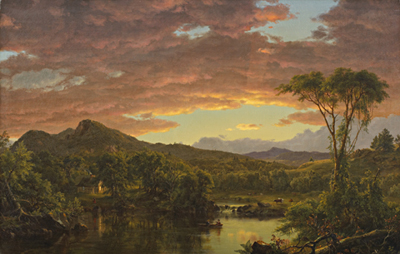The History in Art History: How did this painting get to Seattle?

Frederic Edwin Church (American, 1826-1900), A Country Home, 1854; oil on canvas 32 x 51 in. Gift of Mrs. Paul C. Carmichael, 65.80
For me, a work of art lives on in part by its association with people, places, and times past and present. When we see objects in museums, in isolation, how do we understand them as expressions of a maker’s personal vision and circumstances and of viewers’ expectations in the artist’s own time and over the course of generations? Each object of historical American art that I work with has endured because someone—a collector, a critic, an artist’s descendant, maybe—has been its champion, often when few others were. Historical American art has for so much of our past been overshadowed by the taste in this country for European art, which signaled for so many the ideal of artistic achievement and good taste.
With so few advocates for American art in this country for so many generations, who are the remarkable people who made sure that it found its place before the public? That’s one aspect of American art history that I find especially intriguing. Charting an object’s history of ownership and public exhibitions offers us another path into our collective history, revealing what we have valued as a culture, when, and why. We can’t easily communicate these insights on museum walls, but these questions of taste, of the value of an object to its audience, help us measure the relevance of works of art as cultural touchstones.
This brings me to a question I have about one of the great American paintings in the Seattle Art Museum collection: Frederic Church’s A Country Home, of 1854. Painted in the artist’s New York studio, and originally purchased by a country gentleman upstate, in Geneva, New York, this picture made its way to Seattle, but how? The painting was given to the museum in 1965 by a Mrs. Paul Carmichael. Someone in the past noted that she was the granddaughter of the painting’s original owner, but the fact is, we know nothing about her. The donation of the Church painting seems to have been her only contact with museum director Richard Fuller, and there is but a brief acknowledgment of her generosity in Dr. Fuller’s one letter to her. It seems clear that she was not a familiar museum patron. There are no other museum donations on record from Mrs. Carmichael.
I may never know for certain what guided the mysterious Mrs. Carmichael to give her magnificent Church painting to the Seattle Art Museum, but I can guess that she probably did so in part because—fortunately for us—there was no market for nineteenth century American paintings at that time. Frederic Church, now one of the most familiar and beloved names in American art history, was still obscure as late as 1965. Rare was the museum director who would have ventured into collecting American art in the 1960s, and Dr. Fuller was no exception. Notes on file suggest that he wasn’t sure that the painting was worthy of the museum, and he even considered selling it, it seems. One of the greatest works of art in the museum today, the Church painting entered SAM in 1965 without fanfare and with a certain amount of skepticism about its place in a museum dedicated to artistic excellence. And it would be more than twenty years before the museum would actually seek out other historical American paintings.
I imagine that Mrs. Carmichael was an extraordinary person because hers was an extraordinary family. Her grandfather, General Joseph Gardner Swift—who originally purchased the painting, probably directly from Church and not long after it was painted—was the first graduate of the U.S. Military Academy at West Point. He had a distinguished career as Commandant of the Academy, a civil engineer, a military strategist, and an educator. He was a close relative of James McNeil Whistler’s now famous mother, and it must have pained General Swift that her painter son had been expelled from West Point. He was not an art collector, it seems—General Swift’s will records only a few family pictures, portraits mostly. The great Church canvas stands out as the rare indulgence of his aesthetic side.
I’d love to hear from anyone who has a suggestion as to how we might learn something about Mrs. Carmichael, who gave the museum one of its most celebrated paintings, and at a time when few others anywhere appreciated its quality and historical significance. Though we can be certain of so little, we can see by her gift that Mrs. Paul Carmichael was a woman of uncommon taste and vision.
Patricia Junker, the Ann M. Barwick Curator of American Art, Seattle Art Museum